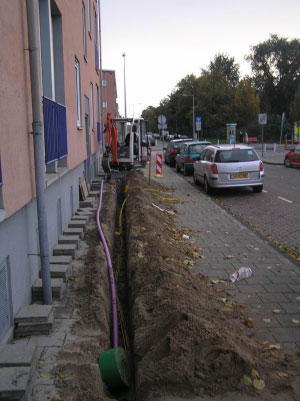
The city of Amsterdam has been involved for several years in building Citynet, a partnership between the city and two private investors to wire 40,000 Amsterdam buildings with fiber. And it's not just fiber, it's open access fiber—any ISP can sign up to use the infrastructure and deliver ultra-fast Internet access.
In 2008, the European Union ruled that the city's involvement in the project was in fact legal, and that it was not improperly interfering in the market.
We asked Herman Wagter, CEO of the company that built the Citynet fiber project, to talk about how he got the job done, and to explain the challenges of rolling out fiber in a densely crowded European city.
Theory versus practice
First, a few basic problems.
Unlike in the US and Japan, stringing fiber along poles is not an option in European capitals. Every fiber cable must be buried below the pavement, then distributed inside a building to apartments; no wires can be exposed on the outside. The density of these old cities is quite high, and real estate is expensive, leaving little room for cabinets with active equipment on the street level. The majority of the housing consists of multi-dwelling-units (MDUs) with up to 500 individual apartments per building, but one can find the occasional houseboat on a canal as well.
When the design of the Amsterdam fiber network started in 2005, it became clear that there was little experience in the market with this type of deployment. Contractors were used to either putting copper wires or coax lines in new buildings, or digging long stretches of big high density polyethylene (HDPE) tubes for backhaul purposes. Most fiber packaging was optimized for backhaul and for metro networks; few products were specifically designed for fiber-to-the-home (FTTH) in these conditions.
Fortunately, most vendors, like Draka, who delivered the fiber in Amsterdam were able to react quickly and rise to the occasion when challenged with specific requirements for the city. The experience in Amsterdam and other European cities has resulted over the years in products like miniature direct burial cables, special high-rise cables with break-out windows to allow very fast builds inside MDUs, fibers that can bend sharply, easy-install Fiber Termination Units (FTUs) inside apartments, and so on.
The learning curve for everyone involved was immense. Only now, after five years, is it tapering off, giving everyone a chance to catch their breath. Here's what we learned from the last half-decade of fiber installs in Amsterdam.
Architecture

Deploying buried cables to every apartment in a dense city is a disruptive process. You do not want to repeat it for decades—preferably longer—so it needs to be done right.
A point-to-point fiber topology runs individual fibers from each apartment back to the local aggregation point (think of the phone system model); it's the most flexible and future-proof topology. Point-to-point will support all known technologies (GPON, active Ethernet, lambda, RF video overlay, and others) by patching individual fibers in the aggregation point. It allows for easy unbundling of individual lines, a feature much appreciated by regulators and customers in Europe.
The alternative topology, PON, features a shared fiber for each 32 to 64 customers. This saves on fiber runs and reduces the number of connectors and the size of the local point of presence gear, but it has one big architectural drawback: more path dependencies. Finally, it is difficult to unbundle a PON topology.
The length of fiber needed to cover the distance from a point of presence (called an aggregation point with active equipment, or APOP) to an apartment is a few kilometers at most, so the cost of the actual fiber is only a small part of the total investment (less than 10 percent).
Handling that many fibers in a point-to-point topology may seem like a problem until the comparison is made with the old equivalent: 100-year old copper cabling for the phone system. Those copper cables are much more bulky than the equivalent fiber cables; in fact, they are four times fatter. Yet we have been able to manage a huge number of copper cables for ages without a problem, so a much slimmer fiber plant should not pose a problem, even when every apartment gets its own line.
So we decided to go for point-to-point in Amsterdam: it did (and does) not make sense to be “penny wise and pound foolish,” by saving on fiber upfront but running the risk of having to redo the outside fiber plant in a decade or two. Paying a slightly higher cost (estimated at 5 percent or less of the total CAPEX budget for the project) for more fiber length and more connectors/patches was considered an acceptable insurance premium against potential premature technical obsolescence.
(In case of Citynet, a second fiber specifically for RF-video was deployed as well, as a shared fiber with optical splitters. In the next build-outs this will be modified to a second point-to-point fiber, as the limitations of a shared fiber became obvious.)
The second decision was to build an open-access, passive fiber plant that would support multiple ISPs in competition. In practice this translates to:
- Unbundled dark fiber access lines which can be rented individually by an ISP who wants to serve that particular customer
- ISPs can get access to APOPs to install their line cards and related equipment, patch in their customer access line, and connect to their own backhaul network
To prevent a clutter of patch cords in the APOP, the patching is limited per group of connections (1,500 to 3,000). If an ISP wants to service a customer within the group, it has to place equipment within the group patch area. A group of 1,500 to 3,000 patches to a limited number of ISPs can be de-cluttered within a reasonable amount of time if the need should arise.
reader comments
75